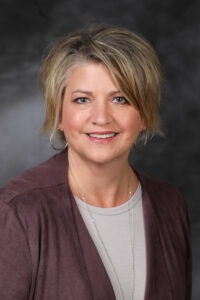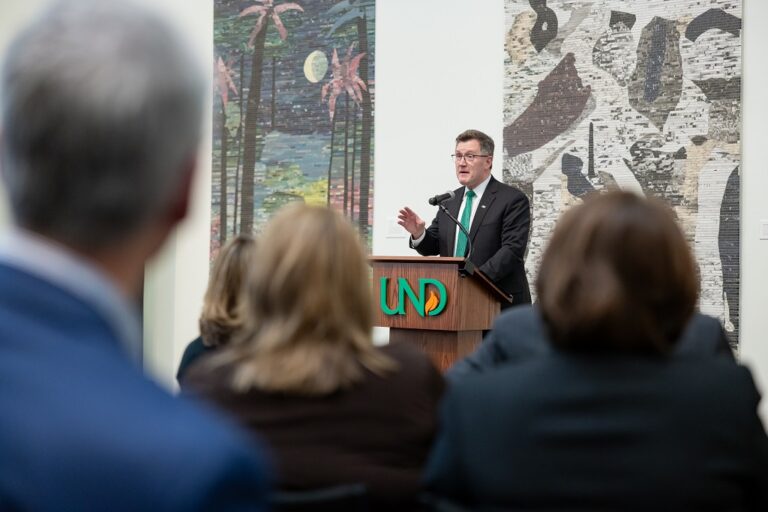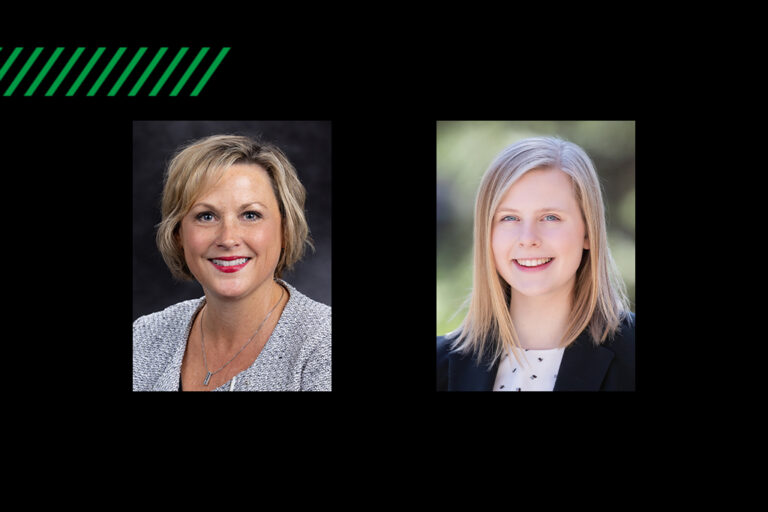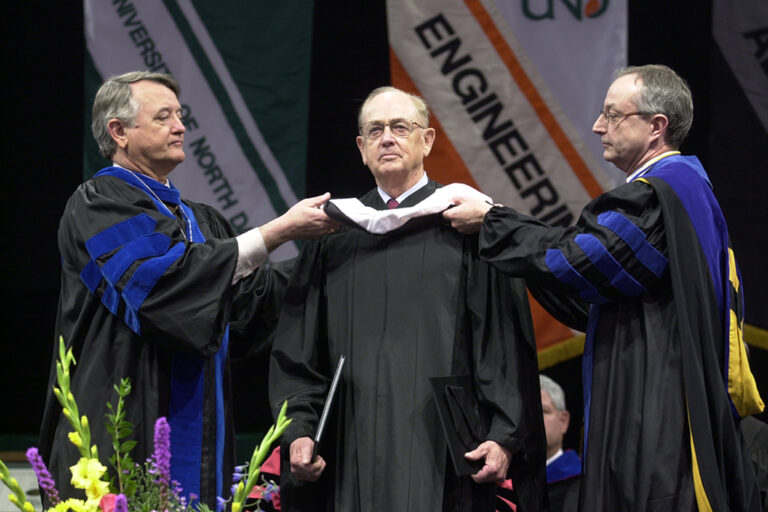On the front lines of the pandemic
Ashley Bayne, assistant director of Public Health, recalls and documents Herculean efforts led by UND

Like the rest of the world in the early days of the grim and gripping pandemic, thousands of North Dakotans sat on their sofas glued to their televisions, newspapers and social media.
Holed up in their homes, they were restless, uneasy and hungry for answers when the only thing that seemed certain was the uncertainty of life itself — both the day-to-day and the heart-beating, lungs-breathing kind.
“People were scared. People were dying,” recalled Ashley Bayne, then-manager and now assistant director of the Public Health Program at UND’s School of Medicine & Health Sciences. She was in the thick of it back then and described it as a time when people probably more than ever welcomed a friendly call from a stranger.
And she would know. More than 180 of those strangers were part of a UND crisis team she quickly assembled to aid an overwhelmed North Dakota Department of Health.
“Some people were incredibly sick, isolated and lonely,” Bayne said. “And sometimes our caseworkers who were calling to check up on them were the only people they talked to every day.”
Looking back at UND lifeline
It’s now been nearly three years since the novel virus first turned the world upside-down, but Bayne says she remembers like yesterday the day she got her own surprise call from state epidemiologist Tracy Miller.
The state needed help, and they needed it fast.
Miller asked: Would anyone at UND be able to assist with case investigations and contact tracing to help slow the spread of the disease?
Though Bayne had the responsibilities of caring for a young son at home and also was juggling an extra load to prepare for Public Health’s reaccreditation, she said there was absolutely no question about what she needed to do.
“I got a couple of students up and running, and before we knew it, we were providing support for the whole state,” she said. “People don’t always realize how important the role of public health is until they really need it. This was full-on crisis mode, but everyone at UND and throughout the community was incredible. Students and professionals were stepping up from everywhere.”
By the numbers
All told, the team Bayne quickly assembled — together with a second team started within UND Student Health Services to track cases for 11 institutions in the North Dakota University System — would provide a critical lifeline of one-on-one support to nearly 50,000 individuals statewide.
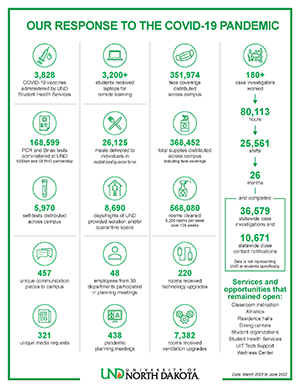
The UND-based teams would complete 36,579 COVID-19 case investigations and 10,671 close contact notifications statewide over the next 26 months. The Herculean effort, she said, amounted to 25,561 shifts, 80,113 hours and more than $2 million in state contracts.
“At times, it felt like we were moving at warp speed. Everything was new to everyone. I was the principal investigator on the contracts, but I had never done this before either,” Bayne said with a laugh. “We had great support, but it’s not like anyone said, ‘OK, here’s the process to follow during a pandemic.’
“There was no process. There was no manual or handbook to follow. It felt like I was building a business from the ground up.”
That business included everything from hiring — at one time, fast-tracking as many as 30 employees in five days — to extensive training and personal development, as well as managing a monster schedule, providing regular feedback, job reviews and even implementing “Caseworker of the Month” for employee recognition.
“I knew keeping the team together was a critical part of keeping the work going, so that was an important part of my job,” Bayne said. “I wanted to make sure everyone knew they were doing very important work and that they knew they were a valued team member — that I cared, the public health community cared and the University cared from the president on down.”
Dr. Joshua Wynne, dean of the UND School of Medicine & Health Sciences, put an exclamation point on that.
“The efforts by our Public Health Program faculty, staff and students to deal with the challenges of the pandemic were nothing short of heroic,” Wynne said. “In many ways, much of the state’s mitigation and education efforts ran through our program, in close coordination with the North Dakota Department of Health. There’s no doubt in my mind that the team here reduced morbidity and saved lives in 2020 and after.”
Into the fire, then a new job
It was grueling work at times, but Bayne echoed its worth in terms of the state’s overall health as well as the level of high-quality experiential learning it provided UND’s Public Health students.
Katarina Domitrovich will attest to that. As a graduate student in the program, she served as one of Bayne’s two lead case managers.
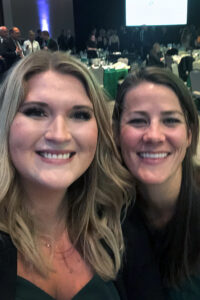
“I think everyone on the team felt we were doing something bigger than ourselves in order to contribute to the public health workforce during an unprecedented time,” Domitrovich said. “We knew what we were doing really mattered, and that’s an experience I’ll always keep close. It allowed me to grow professionally and confidently in the safe space of my UND family, where faculty — and especially my supervisor, Ashley — wanted me to succeed and gave me a safety net of support and resources.”
Further, Domitrovich said she gained valuable connections in the field that led to her current job as health equity coordinator for the North Dakota Department of Health.
Still more people sang the praises of the UND teams in a 175-page report Bayne compiled, in part, to serve as a best practices guide for the future and, in part, to recognize the great accomplishments everyone had made.
One team member said, “Being a part of this (work) has taught me that no matter how big or small your role, no matter how important or unimportant you think you are, you can make the biggest difference in someone’s day.”
And from yet another: “What really stood out to me was how alone and afraid so many people were. In many cases, nobody had told them what to do or what to expect. They had no information, and for us to be able to answer all of their questions, that was probably the most rewarding thing.”
A good lesson for all
All in all, Bayne said she was grateful for the whole experience. UND not only made a huge impact on the health of North Dakota’s residents, but it also impacted the University’s ability to keep many services up and running.
“It was amazing. People just kept showing up every single day, and for the most part, with smiles on their faces,” Bayne said. “I think knowing how many people were involved in similar work across campus and knowing that people’s lives depended on the work we were doing kept us going.
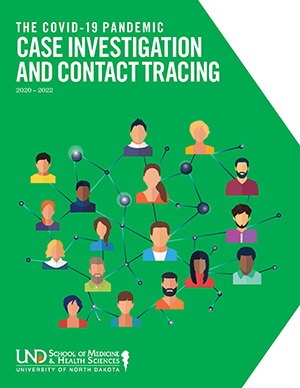
“We were all on the same mission, and people were genuinely proud to be serving the community, their state and the nation. I’ve always been proud to work at UND, but my pride honestly grew a ton after being a part of this.”
Bayne says she’s also proud of the fact that all the hard work showed outsiders just how much public health matters.
“At the peak, we saw an 80% increase in applications for the program from one cycle to the next,” she said, and colleges across the country also reported an increase in inquiries and applications for Public Health degrees.
“The pandemic and the UND experience showed students the power of public health policy,” she said. “They saw how they can be part of that process and how changes in that policy can impact an entire community, state and nation.”
SEE FOR YOURSELF: You can read Bayne’s detailed report, including a timeline, lessons learned, at-a-glance statistics and more personal reflections from team members at the link.
BY THE NUMBERS: Bayne stressed that her team’s work was only one part of UND’s prolonged fight against the pandemic. Hundreds of others campuswide were simultaneously managing vaccines and testing. Click the link to find a by-the-numbers graphic highlighting just some of these efforts. “Behind each one of these little bullet points, there’s a million more details and people making a difference,” Bayne said.
